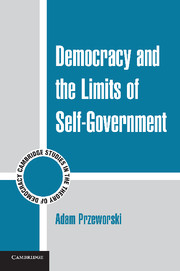Book contents
8 - Democracy as an Implementation of Self-Government in Our Times
Published online by Cambridge University Press: 05 June 2012
Summary
Is “democracy,” as we understand the term today, an implementation of “self-government,” as this ideal was formulated when representative institutions were first established? The evidence is mixed. Reading backwards, our contemporary understanding of democracy into the intentions of the founders of representative institutions is anachronistic. Their ideals – self-government, equality, and liberty – were seminal. During more than 200 years they animated the evolution of representative institutions into what we now see as democracy. This is why we venerate the founders. Unfortunately, some of their ideas were logically incoherent and practically unfeasible, and some manifestly rationalized interests.
Let me reiterate that the issue of intentions cannot be resolved. Wood (1969: 383), for example, makes this claim:
The Americans were not simply making the people a nebulous and unsubstantial source of all political authority. The new conception of a constitution, the development of extralegal conventions, the reliance on instructions, the participation of the people in politics out-of-doors, the clarification of the nature of representation, the never-ending appeals to the people by competing public officials – all gave coherence and reality, even a legal reality, to the hackneyed phrase, the sovereignty of the people.
Yet this is a conclusion of a section that describes the ambiguities and the polemics concerning the relation between the people and their representatives, the role of the people between elections, the locus of sovereignty. Moreover, of this list only “the never-ending appeals to the people by competing public officials” survived the Constitution.
- Type
- Chapter
- Information
- Democracy and the Limits of Self-Government , pp. 161 - 172Publisher: Cambridge University PressPrint publication year: 2010



